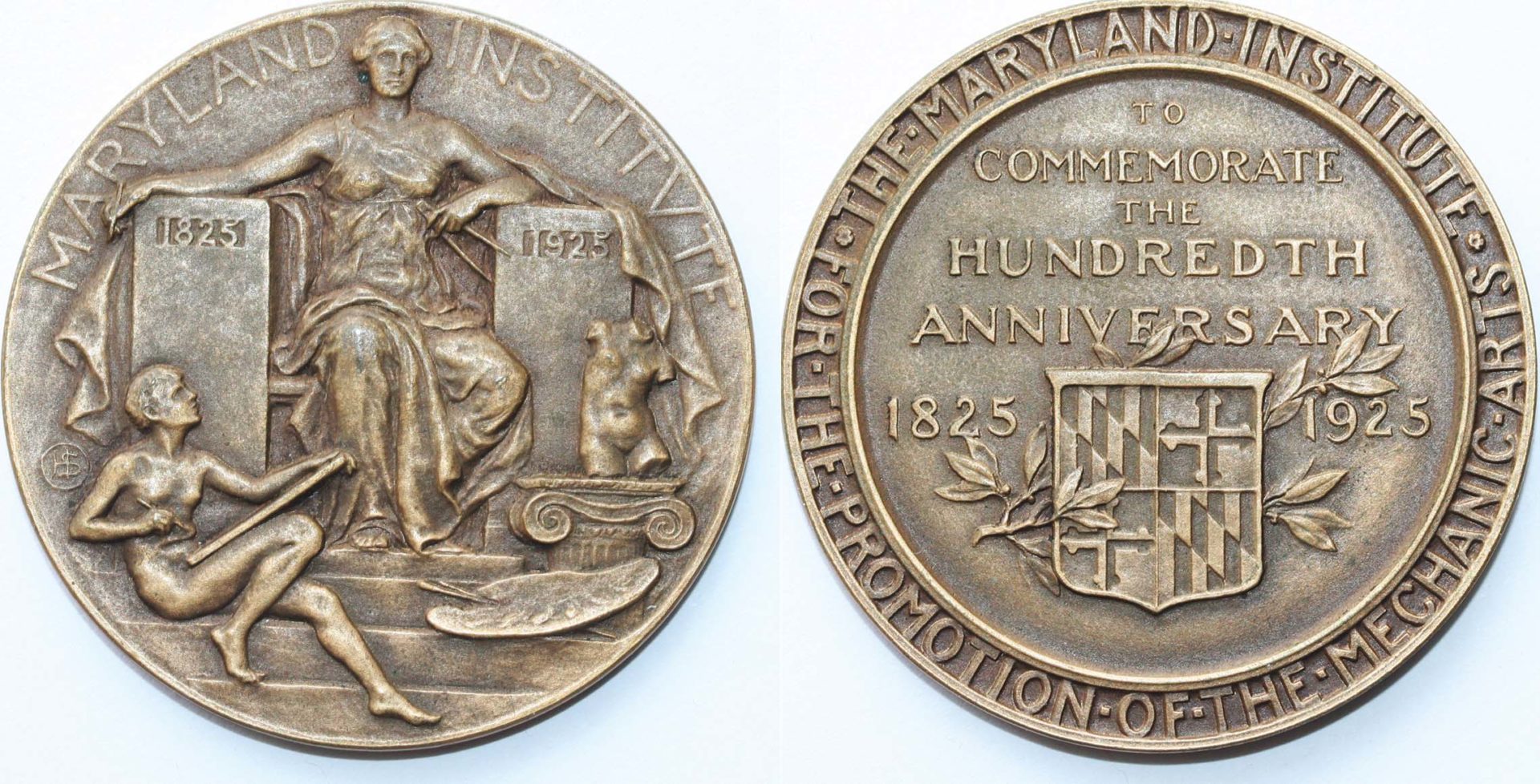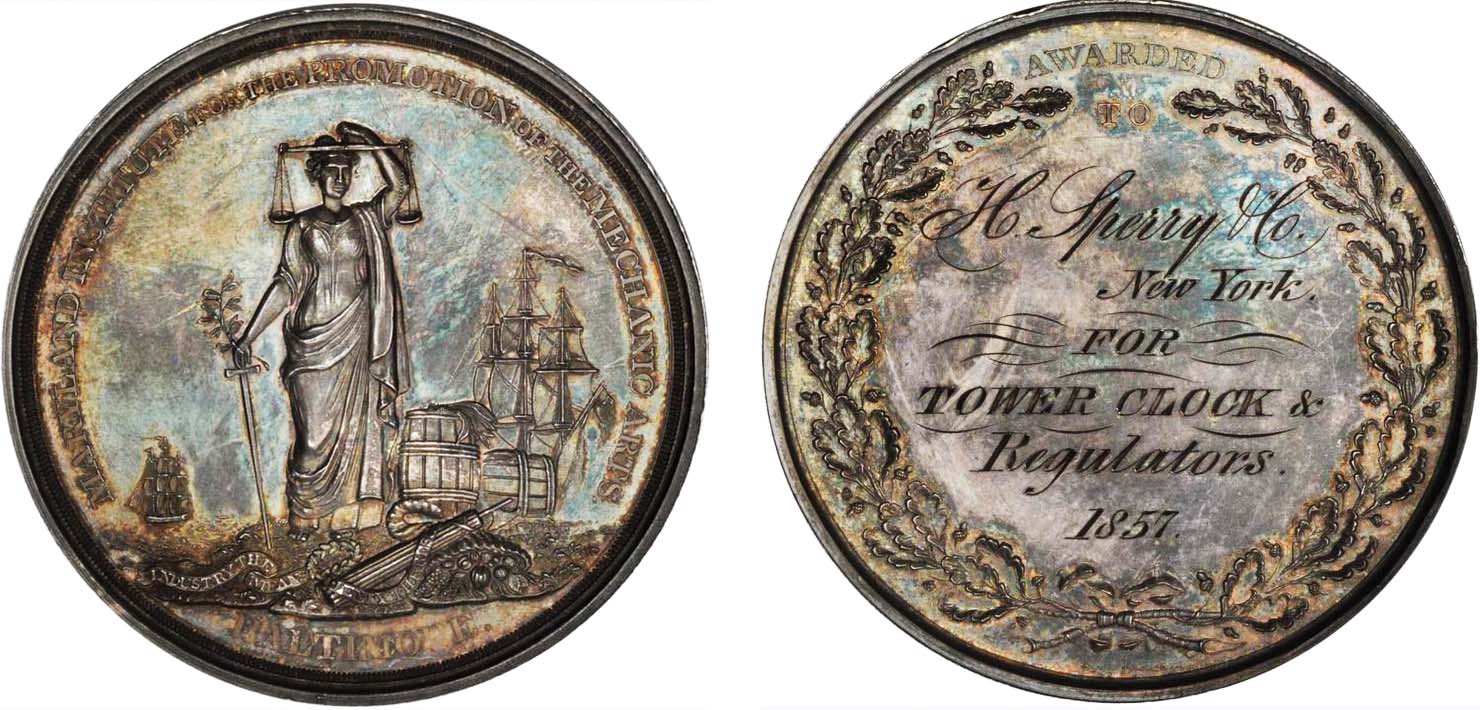College of Art
In May 1925, the Maryland Institute for the Promotion of the Mechanic and Fine Arts celebrated its 100th anniversary and issued medals for the occasion. Hans Schuler became the organization’s director that same year. Born in 1874 in Lorraine, France, Schuler came to America with his parents when he was only 6 years old. He showed an aptitude for art and sculpture at an early age and attended the Maryland Institute. There he studied sculpting. Upon graduating in 1894, he started working in his chosen profession.
A. Vernon Taylor discusses Schuler’s work in an article titled “The Medallic Art of Baltimore Sculptors Hans Schuler & Hans C. Schuler.” The article appears in the August 1985 issue of The Numismatist. Taylor was acquainted with Schuler’s son, Hans C., who was also a sculptor, and an interview with him formed the basis of the article.
To commemorate the Maryland Institute’s milestone, Schuler sculpted a 51mm medal that the Medallic Art Company of New York City struck in gold, silver, and bronze. The company “signed” the issue with incuse lettering on the edge. The reverse depicts part of the Maryland State Seal in the center, with THE MARYLAND INSTITUTE FOR THE PROMOTION OF THE MECHANIC ARTS around the rim. The six-line inscription in the center reads TO/COMMEMORATE/THE/HUNDREDTH/ANNIVERSARY/1825 1925.

Taylor, who catalogs the medal as No. 9, notes that the obverse depicts “the institute’s alma mater together with personifications of ‘Mechanics’ and ‘Fine Arts.’” He reports that the inscription in the center of the reverse die was later removed so the piece could be engraved with a recipient’s name “and produced in gold, silver and bronze as achievement awards for Institute students.” Schuler’s initials are located within a small circle on the obverse, near the rim at 8 o’clock.
Credit for establishing a mechanics and arts institute in Baltimore goes to a young man by the name of John H.B. Latrobe, who got the idea after he learned about the recently formed Franklin Institute in Philadelphia. The organization was incorporated on January 10, 1826, shortly after its formation, and Latrobe was one of its directors. On November 6 of that year, the institute held the first exhibition of American-manufactured articles at Concert Hall on South Charles Street, and a second one took place at the same location in 1827.
The institute occupied a portion of the Athenaeum building, located on the southwest corner of St. Paul and Lexington Streets. On February 7, 1835, a fire destroyed the building and its contents, leaving the organization without a home. The disaster resulted in the dissolution of the organization, which at the time numbered 700 members. A reorganized Maryland Institute was formed on January 12, 1848. Its members wasted no time making arrangements for an exhibition later that year. Many people attended the event, and more than 400 exhibitors vied for diplomas and medals in a variety of classifications. In 1851 the organization moved to their newly completed building in Market Place, above Centre Market.
An article in the May 31, 1925, Baltimore Sun newspaper stated that the institute’s purpose, as formulated in 1848, was to have “a school of design, an annual course of popular lectures, a library and reading rooms, with a cabinet of models and philosophical apparatus, and arrangements for the holding of an annual exhibition with premiums for excellence in the manufactures and mechanic arts.”
The 1848 exhibition opened in November, and the featured speaker was none other than John H.B. Latrobe. The first presenter at the annual course of lectures in December 1849 was Horace Greeley, who was a member of Congress from New York. He spoke on the topic of “Self-Culture, the Paramount Duty of American Young Men.”
Tragedy reared its ugly head again on February 7, 1904, when the Baltimore Fire destroyed the institute’s historical records and burned more than 1,500 buildings. Despite this setback, the organization continued to function and grow. Four years later, it completed its new Main Building on Mount Royal Avenue. The City of Baltimore furnished funds to rebuild Centre Market, where the drafting and other schools resided.
In 1959 the organization changed its name to Maryland Institute College of Art. The institute is still thriving, and hopefully in four years we can look forward to the issuance of 200th-anniversary medals.
I would be remiss if I didn’t note that for many years, the institute issued award medals at its exhibitions, and these frequently appear in the marketplace. Edward Stabler engraved the dies, and the U.S. Mint struck the medals. They appear as AM-29 in R.W. Julian’s 1977 tome, Medals of the United States Mint: The First Century, 1792-1892, published by the Token and Medal Society.
The institute struck the medals with a 28mm diameter in gold, silver, and bronze. However, most of the bronze and silver versions are 51mm. In 1857 H. Sperry & Co. of New York received the illustrated silver piece for “Tower Clock & Regulators.”

A version of this article appeared in the January 2021 issue of The Numismatist (money.org).
